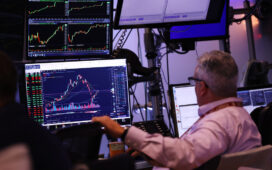All of a sudden, it’s starting to look like the “Magnificent Seven” might be losing some of their shine.
Although it’s difficult to draw conclusions like this from a single trading session, something remarkable happened in the U.S. stock market on Monday that has caught Wall Street’s attention and raised fresh questions about leadership in the U.S. stock market going forward.
All three major U.S. equity indexes finished at fresh 52-week highs, with the Dow Jones Industrial Average
DJIA
closing at its highest level in nearly two years. Yet not a single member of the “Mag 7” finished in the green. Instead, they were all deeply in the red, with every member of the elite group of megacap technology stocks finishing at least 1% lower, except Microsoft Corp.
MSFT,
How unusual is this? Turns out, it’s extremely rare for the Nasdaq to finish higher without any help from its most heavily weighted stocks.
Monday’s session marked only the second time since Facebook parent Meta Platforms Inc. made its market debut in 2012 that the Nasdaq-100
NDX
managed to finish in the green while all seven “Mag 7” stocks closed in the red, according to Dow Jones Market Data. The last time it happened was Nov. 9, 2016, the day after Donald Trump’s upset victory over Hillary Clinton in the U.S. presidential election.
It’s also notable that the PHLX Semiconductor Index
SOX,
a closely watched gauge of the semiconductor industry’s performance, logged a fresh record closing high on Monday without any help from Nvidia Corp.
NVDA,
the artificial-intelligence darling that has seen its sales boom and its share price soar more than 200% this year.
The PHLX semiconductor index
SOX
rose 3.4% to finish Monday at 3,902.38. The Magnificent Seven includes seven of the most valuable companies trading in the U.S.: Meta Platforms
META,
Apple Inc.
AAPL,
Nvidia, Microsoft, Amazon.com Inc.
AMZN,
Alphabet Inc.
GOOG,
GOOGL,
and Tesla Corp.
TSLA,
The fact that all of this is happening now makes it even more notable, market strategists said.
As the end of the year approaches, investors are trying to anticipate who the new stock-market leaders might be in 2024, following a year when investing returns were dominated by just seven stocks.
“Considering that the Mag 7 is over 40% of the weight of Nasdaq 100, it’s pretty amazing that NDX is up,” said Steve Sosnick, chief market strategist at Interactive Brokers, during a phone interview with MarketWatch. “It’s unsustainable to think that you could have a market where seven stocks lead pretty much everything. At some point, you have to hope that the other 493 [members of the S&P 500] catch up.”
But Sosnick cautioned against interpreting Monday’s moves as an indication that the long-anticipated rotation in sector leadership is underway, just in time to keep the bull market going in 2024.
To be sure, market breadth was fairly strong on Monday, which likely helped offset some of the drag from the Mag 7. In the Nasdaq-100, 87 stocks finished higher, the most for a single day since 90 on Nov. 20.
For the S&P 500, 366 stocks rose, the most since Dec. 1, according to Dow Jones data. The Russell 3000
RUA,
which seeks to track the entire U.S. market, rose 0.4% to close at 2,652.24, its highest since April 2022, according to Dow Jones data. Meanwhile, in the S&P 500, defensive sectors like consumer staples outperformed, according to FactSet data.
Despite this, the big action on Monday remained in semiconductors, which saw a big boost from a 9% gain in shares of Broadcom
AVGO,
that pushed its shares to a new record just shy of $1,030.
Semis aren’t exactly a laggard. The Philly semiconductor index mentioned earlier is up more than 54% year to date, according to FactSet data.
“Investors remain enamored with tech. Now, it looks like they’re focusing on the next tier of technology stocks.”





